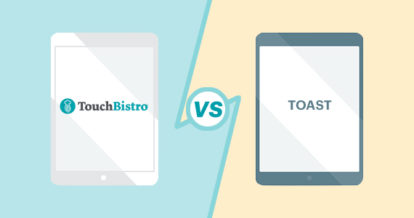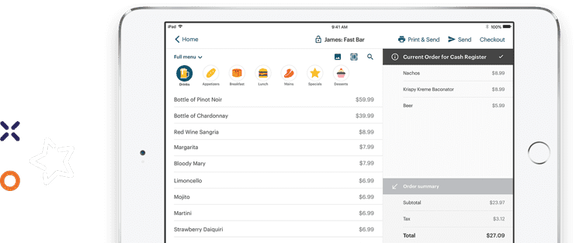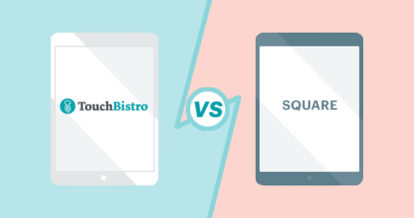| Don’t have time to read the full article? Here are the highlights |
| TouchBistro: – Restaurant-specific solution – Runs on iOS and Apple iPad tablets – A cloud-based solution with a built-in offline mode – Extensive in-house solutions, including integrated reservations and online ordering – Best for single and multi-location restaurants that are growing and scaling Toast: – A restaurant-specific POS solution – Runs on an Android operating system and requires the purchase of proprietary Android hardware – Limited product availability in some regions – Opaque payment processing terms – Best for niche multi-location restaurant concepts in need of a more customized solution |
If you’re in the market for a new restaurant POS system, you’ve probably considered two of the most popular options out there: TouchBistro vs Toast.
While both POS systems were created specifically to meet the needs of restaurants, there are some important differences between the two. From the operating system and type of hardware used, to add-on products available, it’s important to know what each system offers before switching POS providers.
That’s where this guide comes in. To help you narrow down your options, we’ve done your homework for you and conducted a head-to-head restaurant POS system comparison of TouchBistro vs Toast on all the features that matter to today’s restaurateurs.
To find out how these top restaurant POS systems stack up, this guide will compare TouchBistro vs Toast on the following:
- The foundations of each system
- Core POS features
- Hardware
- Payments
- Other add-on solutions
- Pricing
- Integration partners
- Customer support
With this head-to-head comparison of TouchBistro vs Toast, you’ll have all the information you need to make an informed decision about which POS system is right for your restaurant. You can also learn more about other top POS providers with our Ultimate Guide to the Best Restaurant POS Systems.
The information contained on this site is accurate as of the time of publication.
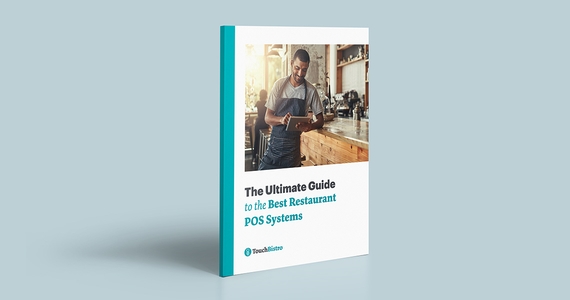
Compare the top restaurant POS systems on features, pricing, payments, and more.
TouchBistro vs Toast: An Overview
Both TouchBistro and Toast are industry-leading POS systems built for modern restaurant management. Both companies are highly rated and designed specifically to meet the needs of restaurants, cafes, bars, and other foodservice establishments.
But while TouchBistro and Toast may seem similar upon first glance, there are some important differences between the two systems. Below, we’ll provide a quick overview of Toast vs TouchBistro, including how the systems differ, overall POS performance, and what that means for restaurateurs weighing their POS options.
| TouchBistro | Toast | |
| POS System | Cloud-based | Cloud-based |
| Operating System | iOS | Android |
| Regional Availability | CAD, U.S., and more | U.S., CAD, U.K., and Ireland |
| Hardware (Tablets) | iPads | Android tablets |
1. POS System
On the whole, TouchBistro and Toast are fairly similar systems. Both are cloud-based systems, which means that your data is stored in the cloud on remote servers. Cloud-based systems allow you to access your information remotely over the internet, which is not the case with traditional, legacy POS systems.
Both TouchBistro and Toast are also equipped with a built-in offline mode. This offline mode ensures that if the internet goes out, staff can continue to use the POS to update and close out orders and accept offline payments. TouchBistro POS also continues speaking to your KDS, which means you can continue sending orders to the kitchen.
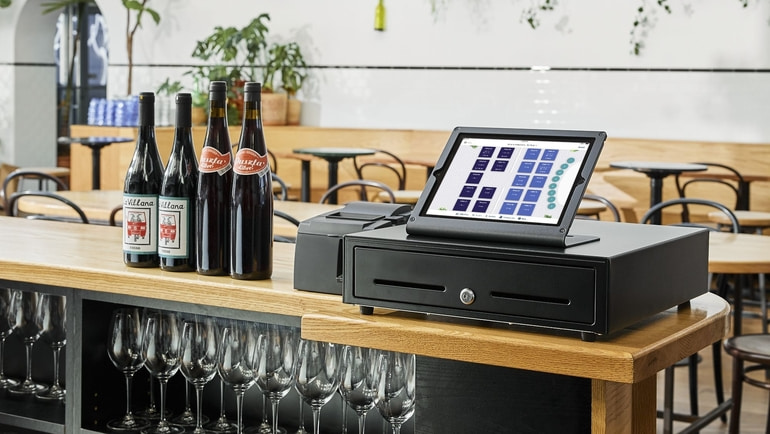
2. Operating System
Though both are cloud-based systems, one major difference between TouchBistro vs Toast is the operating system that each POS runs on.
Toast is powered by an Android operating system. Android systems are known for their flexibility and customized solutions, which can be a plus if you need a bespoke solution for your restaurant. However, the Android operating system comes with a steep learning curve and updates are often fragmented due to the variances in available hardware. Not to mention, Android systems are the primary target of malware, meaning they are at a higher risk of security breaches.
In contrast, TouchBistro runs on Apple’s iOS operating system. The biggest benefit of iOS is that it’s a closed platform, meaning it’s less virus-prone than Android systems and updates are rolled out seamlessly across devices. And while iOS offers fewer opportunities for customization, this can actually be a good thing. Less customization results in more consistency, meaning the user-friendly system is easy for staff to pick up – especially if they’re already familiar with Apple products.
3. Regional Availability
While the type of POS and operating system are a matter of preference, regional availability can be an immediate deal-breaker.
Toast is available in the U.S. Canada, U.K., and Ireland. However, most of the platform’s features are only available in the U.S. This means that while restaurants in Canada, the U.K., and Ireland can sign up with Toast, they only have access to limited features and add-ons.
TouchBistro is also available in the U.S., Canada, the U.S., and Mexico. However, unlike Toast, TouchBistro offers virtually the same product suite in the U.S. and Canada, so customers do not have to worry that certain products may not be available in their region.
4. Company Structure
When choosing a new POS system, company structure is not something every operator researches, but it can make more of an impact than you might think.
Toast is a public company that IPOed in September of 2021. Since that time, most of Toast’s decisions have been largely made in the interest of its shareholders, rather than its customers, including the introduction of a $1 fee for consumers (which was quickly met with backlash) and laying off 550 employees.
In contrast, TouchBistro is a private company, which means its decisions are not driven by a need to satisfy shareholders. Indeed, with its mission to fuel the success of independent restaurants, TouchBistro always has, and continues to, put people before profits.
Core POS Features
If you do a restaurant POS system comparison of all the biggest players, you’ll find a number of common features, including menu management, floorplan management, and tableside ordering. These are the primary POS functions that every restaurant relies on to streamline and improve operations.
| Core POS Features | TouchBistro | Toast |
| Menu Management | ✔ | ✔ |
| Staff Management | ✔ | ✔ |
| Floor Plan Management | ✔ | ✔ |
| Tableside Ordering | ✔ | ✔ |
| Reporting | ✔ | ✔ |
| 1:1 Onboarding | ✔ | ✔ |
| Customer Support | 24/7/365 | 24/7/365 |
When you compare Toast vs TouchBistro on core POS features, both platforms are equipped with the following:
- Menu Management: Build and manage multiple menus and menu categories.
- Staff Management: Manage employees with personalized accounts and employee-specific access permissions.
- Floor Plan Management: Design your restaurant floor plan, take orders by table, move parties around, split checks, and more.
- Tableside Ordering: POS tablets can be taken tableside for faster and more accurate order taking.
- Reporting: Real-time and end-of-day cloud reporting on everything from sales to staff activity.
For the most part, TouchBistro and Toast are equipped with very similar POS features, all of which help to make running your restaurant easier and more efficient.
Though the two platforms are very similar, Toast does offer a bit more when it comes to enterprise functionality. Some of Toast’s features are a bit more customizable, which may be a plus for large, nation-wide restaurant chains. However, most single and multi-location operators will not need this level of customization. In fact, the sheer number of complex functions that Toast offers can sometimes make navigating the software overwhelming and slow down the initial training process.
Though TouchBistro is missing some enterprise functionality, the system is equipped with robust multi-unit management features. For instance, TouchBistro allows multi-venue owners to easily create, manage, and bulk-edit menus across multiple locations, for quick and seamless multi-location management from a single device. Not to mention, all of TouchBistro’s features are designed with ease of use in mind, so you never have to worry about complicated software slowing you or your staff down.

Compare the top restaurant POS systems on features, pricing, payments, and more.
Hardware
With a better understanding of each POS system, it’s time to address the issue of hardware. Though POS hardware encompasses everything from the cash drawer to the receipt printer, it’s the tablets that run POS software that vary most between systems.
Toast Android Tablets
Toast strongly encourages its customers to purchase Toast’s own hardware, which includes its proprietary Toast Flex tablets, Elo Touch tablets, and custom-built devices like Toast Go — all of which run on an Android operating system.
While Android tablets are well suited to restaurants, Toast’s strict hardware requirements come with some potential drawbacks. For instance, one downside to Toast’s hardware setup is that it relies solely on Android devices, which tend to have a less seamless integration between the hardware and the software than Apple products. Though this is unlikely to cause any problems if you’re using Toast’s proprietary hardware, it could be an issue if you opt to use your own Android devices (something that Toast discourages).
Beyond the technical considerations, it’s also important to think about the user experience. If you are already familiar with Android devices, Toast’s hardware will be nothing new. However, if you (or your staff) tend to favor Apple devices, Toast’s Android tablets come with a steeper learning curve, which could slow down the training process.

TouchBistro iPads
On the other hand, TouchBistro runs on iOS, which means that the only POS tablets you can use are iPads. Like Toast, this means that you’re limited to a fairly small selection of available tablets. However, you’re not obligated to purchase your tablets directly from TouchBistro, which could save you money if you already own an iPad. Not to mention, used iPads are incredibly easy to source if needed.
In addition to being readily available, iPads also have some major technological advantages. Unlike Android devices, iPads integrate seamlessly with iOS software. This is because Apple owns both the hardware (the iPad) and the software (iOS) so the two are designed to work in tandem with one another for seamless integration. As a result, iOS security updates will roll out automatically across all Apple devices, ensuring your software is never out of date.
Finally, iPads are a very intuitive out-of-the-box solution – even for staff who aren’t familiar with Apple devices. This can help to speed up the training process and make it easier for staff to troubleshoot if issues arise.
Add-On Solutions
Both Toast and TouchBistro offer additional, add-on features, which allow restaurants to expand the functionality of their POS systems. These add-on solutions include everything from payment processing and online ordering, to customer loyalty programs and reservations.
Payments
While TouchBistro and Toast may offer similar core POS features, when it comes to payment processing solutions, there are a few differences.
| Payments | TouchBistro | Toast |
| Payments Pricing Model | Fixed rate and interchange plus pricing | Fixed rate and interchange plus pricing |
While TouchBistro and Toast may offer similar core POS features, when it comes to payment processing solutions, there are a few noteworthy differences.
Both TouchBistro and Toast offer integrated payment processing solutions for your restaurant. The benefit of using an integrated payment processing solution is that all your data flows directly from your POS through to your payment terminals, saving your staff time and eliminating errors caused by manual entry.
Since it began offering integrated payment processing, TouchBistro has always been transparent and upfront about its terms, so you always know exactly what you’re paying for. With TouchBistro, you also enjoy some of the most competitive payment processing rates out there, without any hidden junk fees.
Unfortunately, it’s tough to say the same about Toast. In June of 2023, Toast announced it would be introducing a 99-cent fee paid by guests on orders of $10 or higher placed through Toast’s online ordering channels. This charge was implemented as a hidden “junk” fee on consumers’ bills, which many operators viewed as sneaky and underhanded. And while Toast later reversed course on its decision, it’s clear that the company has no qualms about adjusting its payment processing terms on a dime, simply to squeeze a little more out of restaurants and their customers.
Other Add-On Solutions
Though payment processing is one of the most common add-on solutions, both TouchBistro and Toast offer additional POS features.
| Add-On Solutions | TouchBistro | Toast |
| Integrated Payments | ✔ | ✔ |
| Inventory | ✔ | ✔ |
| Labor Management and Staff Scheduling | ✔ | ✔ |
| Online Ordering | ✔ | ✔ |
| Integrated Delivery | ✔ | ✔ |
| Reservations | ✔ | ✔ |
| Gift Cards | ✔ | ✔ |
| Loyalty and Customer Relationship Management | ✔ | ✔ |
| Marketing | ✔ | ✔ |
| Back Office Management | ✔ | ✔ |
| Self-Serve Kiosks | ✘ | ✔ |
| Kitchen Display System | ✔ | ✔ |
| Customer Facing Display | ✔ | ✔ |
| Digital Menu Board | ✘ | ✘ |
The way both providers structure their packages, restaurants can pick and choose which add-on features they want based on the specific needs of their restaurant. When comparing Toast vs TouchBistro, both offer the following add-on features:
- Payments: Integrated or standalone payment processing services.
- Inventory: This automated inventory management solution does the heavy-lifting with a digital database of all your items and up-to-date counts of your consumables.
- Labor Management: Staff scheduling tools and labor management automations make it faster and more cost-effective to manage staff.
- Online Ordering: Customers can order directly from a restaurant’s website and the order is processed through the POS in real-time – commission-free.
- Delivery: Restaurants gain access to an on-demand network of local drivers for quick and convenient door-to-door delivery.
- Gift Cards: Branded physical gift cards with multi-location reconciliation.
- Loyalty and CRM: An integrated CRM and rewards program that helps drive repeat visits.
- Marketing: A marketing solution that helps restaurants create and automate custom marketing campaigns.
- Profit and Back Office Management: Streamline operations and maximize profitability with a back office solution that helps you manage inventory, invoicing, bill payments, and more.
- Reservations: An integrated reservations management and waitlist system that lets guests reserve tablets online and helps restaurants manage their bookings.
- Kitchen Display System (KDS): A digital system that improves efficiency by displaying order tickets sent directly from the POS.
- Customer Facing Display: A counter-service system that faces the customer so they can visually confirm their order.
Beyond these common add-on features, Toast offers a few additional add-on options that TouchBistro does not. For instance, the company offers a self-ordering kiosk solution, which allows guests to place their orders independently on a touchscreen tablet for quick and easy customization. Orders are then sent directly from the kiosk to the KDS.
In contrast, some of TouchBistro’s add-ons are more robust than Toast’s, including its reservation management software. TouchBistro Reservations is a complete reservation and guest management platform that allows you to accept and manage mobile and web reservations. These reservations sync directly to your POS for a seamless flow of information between the front of house and back of house. Restaurants that use TouchBistro Reservations are also automatically listed on the TouchBistro Dine platform, allowing them to tap into an existing customer network.
Toast also recently began offering reservations through an in-house solution called Toast Tables. Toast Tables integrates with the brand’s POS, making it easier for servers to manage bookings in real time. However, one major drawback to the solution is that there’s no online discovery platform for diners to find new restaurants and book a table. This limited reach means that the solution is only useful to restaurants that already have a strong website presence and can expect diners to specifically come to their website to make a booking.

Compare the top restaurant POS systems on features, pricing, payments, and more.
Integration Partners
Beyond their own platforms, TouchBistro and Toast also support integrations for third-party software that can be synced with your POS system. These best-in-class partners offer specialized solutions and services for tasks such as accounting, loyalty, delivery, and more.
| Integration Partners | TouchBistro | Toast |
| Online Ordering and Delivery | ✔ | ✔ |
| Reservations | ✘ (in-house solution) | ✔ |
| Loyalty | ✘ (in-house solution) | ✔ |
| Staff Management, HR, and Payroll | ✔ | ✔ |
| Inventory Management | ✔ | ✔ |
| Accounting | ✔ | ✔ |
| Reporting and Analytics | ✔ | ✔ |
Both TouchBistro and Toast offer integrations for the following kinds of services:
- Online Ordering and Delivery Marketplaces: Includes both third-party apps such as DoorDash, as well as aggregators like Odermark and Deliverect that sync multiple different third-party ordering apps with your POS system.
- Staff Management, HR, and Payroll: Employee scheduling and labor management tools like 7shifts, as well as payroll providers like Push Operations.
- Inventory Management: Advanced inventory management tools such as MarketMan.
- Accounting: Accounting tools such as Quickbooks and middleware software like Shogo.
- Reporting and Analytics: Advanced reporting and business insights through software such as Avero.
If you’re comparing TouchBistro vs Toast on the sheer number of integration partners, there’s no doubt that Toast comes out on top. Toast also has an open API, which means you can develop your own integrations if you choose to.
While TouchBistro does not offer as many integrations, the ones it does support are industry-leading tools that are already used by many restaurants. For instance, TouchBistro supports popular scheduling software such as 7shifts, workforce management software like Restaurant365, and online ordering aggregators like Deliverect. For most restaurants, this narrow list of choices may be preferable to choosing between dozens of different integrations that carry out virtually the same functions.

Pricing
If you’re comparing TouchBistro vs Toast, there’s probably one big factor that could be a deal-breaker: the cost. Fortunately, both companies have fairly straightforward pricing structures.
| Pricing | TouchBistro | Toast |
| Software Pricing | Starting at $69 USD / month for a single license | Starter Kit: $0 USD / month Point of Sale: starting at $69 USD / month Custom: custom pricing |
Toast’s Starter Kit package is priced at $0 per month for the most basic POS setup and a maximum of two terminals. While this sounds like a great deal, keep in mind that you will need to pay for Toast Payments and any additional features you require. As a result, the Starter Kit Package is really best for food trucks, cafes, and bakeries – not restaurants – looking to get up and running very quickly.
Toast’s more complete offering is its Point of Sale package, which is better suited to restaurants and starts at $69 per month. However, this package only includes the POS, which means any additional solutions will cost you extra.
Like Toast, TouchBistro has different tiers of pricing based on what you need, with software fees starting at $69 per month for one license.
All of TouchBistro’s plans include the core POS features, unlimited users, free updates, and 24/7/365 support. And like Toast, you will have to pay extra for some of TouchBistro’s add-on features, such as Online Ordering, Gift Cards, Reservations, and Loyalty.
Regardless of which system you choose, you’ll also need to consider the cost of hardware (tablets, printers, servers, etc.), and any installation and setup fees. However, these fees can vary wildly depending on the restaurant and your setup, so it’s best to get a quote upfront.

Compare the top restaurant POS systems on features, pricing, payments, and more.
Customer Support
To support their core POS features and any add-on solutions, both TouchBistro and Toast offer round-the-clock technical support and customer service. Both companies offer 24/7 support via phone or email, 365 days of the year. This means that restaurateurs can get answers to any questions or issues, no matter what time of day it is. Both companies also boast extensive resource libraries with step-by-step guides and videos that staff can use to troubleshoot any issues.
TouchBistro vs Toast: The Bottom Line
When you compare TouchBistro vs Toast directly, it’s clear that both POS systems can handle the needs of most restaurants, cafes, bars, food trucks, and breweries. Both systems have similar core POS features, and a lengthy list of add-ons and integrations that can help restaurants solve a variety of different challenges.
When faced with a choice between the two systems, Toast might be the better option for niche restaurant concepts in need of a more bespoke and flexible solution. Toast not only offers more enterprise-level features, but it also supports more opportunities for customization and offers a lengthy list of niche third-party integrations.
In contrast, TouchBistro is a better all-around POS solution for single and multi-location restaurants – including restaurant groups and regional chains – for three main reasons:
1. Transparent Terms
When it comes to payment processing, transparency is paramount. In fact, the 2024 State of Restaurants Reports found that a lack of transparency was one of the most prevalent frustrations that operators have with payment processors. Fortunately, this is not a concern with TouchBistro. Not only does TouchBistro offer transparent payment processing terms and equitable rates, but you also get the security of knowing you’re partnering with a trusted payment processor.
In contrast, Toast is far less transparent with its own terms. As mentioned, Toast introduced a 99-cent fee on online orders and then hid this fee from the very guests who would be paying for it. This not only shows a lack of concern for the impact on operators, but also demonstrates that Toast has no qualm about changing its term to squeeze a little extra money out of operators.
2. Apple Hardware and iOS Operating System
TouchBistro runs on an iOS operating system and uses Apple hardware. While Android systems have their advantages, Apple is generally considered the more reliable and user-friendly option when it comes to restaurant POS systems.
When you’re running a business as fast-paced as a restaurant, you need POS hardware and software that integrate seamlessly – you don’t want your servers fiddling with settings or restarting devices in the middle of service. Since Apple owns both the hardware (the iPad) and the software (iOS), the two are specifically designed to work in tandem for a seamless integration between your POS software and tablets – something that’s not a given with all Android systems.
3. In-House Solutions vs Third-Party Integrations
TouchBistro bills itself as an all-in-one restaurant management system and it truly lives up to that name. Over the years, TouchBistro has developed in-house solutions for every aspect of restaurant management, including solutions for the front of house, back of house, and guest engagement. With so many integrated, in-house solutions available, TouchBistro only offers integrations with best-in-class partners for very specialized functions such as payroll processing or vendor management.
While it may not seem like it may make a huge difference, using in-house solutions instead of third-party integrations results in smoother and more seamless operations. With TouchBistro all your data flows from one product to the next and you only need to consult one single platform to get all the information you need. In contrast, Toast’s heavy reliance on third-party providers can sometimes result in more disjointed operations and a more fragmented user experience overall.
At the end of the day, every restaurant is different and you know what you need from your restaurant POS better than anyone else. And now that you’re armed with the information in this restaurant POS system comparison, you’ll have a little more context when making a decision between TouchBistro vs Toast.
Know a friend using Toast? Refer them to TouchBistro and get rewarded.
